Parking Equity: Deterring Access Aisle Parking Violations
This information is available in PDF format upon request.
Background: Why It Matters
Access aisles are the diagonally marked spaces adjacent to the accessible parking spaces that are designed for use by people with disabilities. Access aisles are usually marked with yellow, white, or blue diagonal stripes. These spaces provide many people with disabilities the extra room they need to get in and out of their vehicles, which may be equipped with a ramp or lift.
However, if this area is blocked – even a small amount – a person with a disability may not be able to exit or enter his or her vehicle.
Additionally, if the person finds a car parked over or on top of an access aisle upon their return, the person may have to wait hours until the violator returns to move the vehicle.
These barriers to equal parking can cause wheelchair users to avoid participating in their communities.
Two Types of Accessible Parking Spaces
There are two types of accessible parking spaces: van-accessible and standard.
Van-accessible parking spaces provide enough room for a person who uses a ramp- or lift-equipped vehicle (RLEV) to lower the ramp/lift so that a wheelchair user can safely enter and exit the vehicle. Ramps and lifts usually lower on the right (passenger) side of the vehicle, though some vans have a ramp/lift in the back. Two van-accessible layouts are acceptable according to the 2010 Americans with Disability Act (ADA) standards (see illustration below). Both options total 16 feet:
- An 8-foot accessible parking space with an adjacent 8-foot access aisle.
- An 11-foot accessible parking space with an adjacent 5-foot access aisle.
Standard accessible parking spaces are required to have access aisles, too, but they are only required to have an 8-foot accessible parking space with an adjacent 5-foot access aisle (13 feet total). Standard access aisles accommodate people with disabilities who use wheelchairs, walkers, and other assistive devices by providing the needed extra space to enter and exit their vehicles.
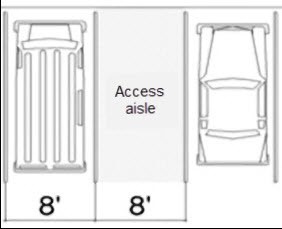
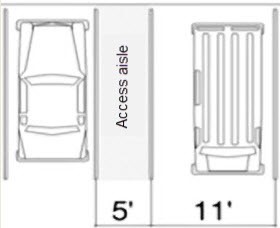
Purpose of This Research
The 2010 ADA Standards require that van- accessible parking spaces be marked with signs. However, there are no national requirements for the markings of access aisles.
This has led some states (for example, Hawaii, Maryland, and South Dakota) to take the initiative to go beyond federal regulations and require “No Parking in Access Aisle” signs.
While states may choose to adopt signs to deter access aisle violations, no known study has experimentally evaluated if the use of signs and pavement markings to deter parking in access aisles is really “best practice” or best guess. Additionally, no known research has specifically examined access aisle violations or interventions that work best to deter them.
This research addresses those issues. The study examined the effectiveness of several environmental interventions to deter the number of violations in which drivers park on top of or encroach upon the access aisle.
Qualitative Study: Focus Group
Before experimenting on-site with signs and pavement markings, we conducted a focus group with eight participants who regularly use access aisles to get in and out of their vehicles. This group included four males and four females, ranging in age from 49-70-years-old. Seven were people with disabilities and one was an informal caregiver who drove for another member of the group.
Focus Group Findings: Focus group members expressed many shared concerns about the status of accessible parking and access aisles and offered ideas for the study. They noted these common barriers to parking:
- Lack of usable van-accessible parking spaces
- Objects blocking access aisles or parking spaces
- Unique parking strategies that block the access aisles
- Insufficient marking and labeling of access aisles
Quantitative Study One: Experiment with Signs and Pavement Markings
We conducted experimental studies at two sites, both grocery stores, in a mid-sized Midwestern city. The first experimental study at Site 1 tested the effectiveness of “No Parking in Access Aisle” signs combined with “No Parking” pavement markings.
Focus group participants suggested the combined signs and pavement markings as ways to deter parking violations, echoing the use of signs by Hawaii, Maryland, and South Dakota.
Research Methods: Data were collected using two time-lapse video cameras (Day 6 Outdoors™ PlotWatcher Pro), and a sign (including threat of a fine) was also posted to indicate that recording was being conducted. Data collection took place for 12 hours per day between the hours of 7:00 a.m. to 7:00 p.m.
Findings: Results indicate that the combined signs and pavement markings did not demonstrate a clear effect in deterring access aisle parking violations.
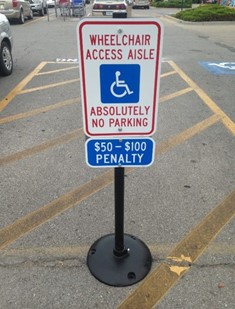
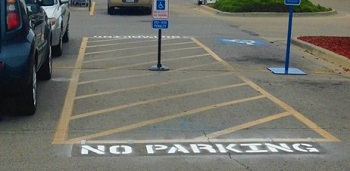
Quantitative Study Two: Experiment with Parking Layout
The experimental study at Site 2 tested the effects of the parking layout on access aisle parking violations, including aisle width and curb placement. The focus group suggested that uneven surfaces may be a potential reason for access aisle parking violations.
After observing high rates of parking violations at Site 1, the researchers also hypothesized that the width of the parking space combined with uneven terrain adjacent to the curb may have contributed to the high rates of access aisle parking violations observed in that particular space.
Site 2 was excluded from the initial intervention using signs and pavement marking because low rates of access aisle parking violations were initially observed there. We hypothesized that the unique parking layout contributes to the low instances of access aisle parking violations. In addition to the access aisle on the passenger side of this 9’8” wide parking space, there was also a 4-foot-wide diagonally striped “courtesy aisle” on the driver’s side, adjacent to the curb. This extra room may be responsible for deterring access aisle parking violations in this space.
Research Methods: In order to test this hypothesis, the researchers obstructed the extra space offered by the courtesy aisle to test the effects of the remaining layout on deterring access aisle parking violations. They built a temporary curb to make the accessible parking spaces at Site 2 similar in width to those at Site 1.
Findings: The data suggest that the width of accessible parking spaces may help to deter both the frequency and severity of access aisle parking violations, especially when spaces comply with the 2010 ADA Standards noted above.
However, direct observation via video recordings demonstrated that on many occasions even an 8-foot- wide parking space is not always enough for people with disabilities to safely navigate in and out of their vehicles. Upon reviewing video of specific instances of access aisle parking violations at Site 2, researchers observed that many people with disabilities purposely violated the space designated by the access aisle in order to have more room to fully open their vehicle’s door and navigate the space with a wheelchair, scooter, walker, cane, or crutches.
Lessons Learned
- The problem of access aisle violations is of critical importance for community participation and inclusion of people with disabilities who use access aisles to get in and out of their vehicles.
- Current state initiatives to address access aisle parking violations (e.g., signs and pavement markings) may not be effective alone in deterring the frequency and severity of these violations.
- Focus group members said they think that many access aisle violators “Don’t think about it,” “Don’t understand,” or “Don’t care.” However, observations indicate that many of the violators are people with disabilities themselves, who use the extra space to safely navigate the limited space adjacent to curbs or closely parked vehicles.
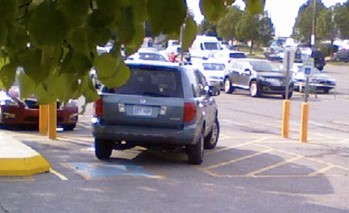
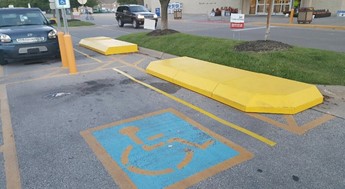
Directions for Future Research
- Examine the effects of various parking layouts on access aisle parking violations (for example, the 11-foot accessible parking space with the adjacent 5-foot access aisle).
- Collect additional data to support the conclusion that it is the width of the parking space, and not some other contributing factor, that is best for deterring access aisle parking violations.
Implications for Change
- Revise public policies. Two options are possible:
- Provide universal access – i.e., an 11-foot accessible parking space with an adjacent 5-foot access aisle – for all accessible parking spaces.
- Provide access aisles on both sides of accessible parking spaces to ensure that there is room on either side for people with disabilities to safely and conveniently enter and exit their vehicles.
- Conduct an education campaign among the disability community to raise awareness about the importance of keeping access aisles free of barriers.
- Advocate for information about accessible parking to be included in state tests for driver education and licensing and for those receiving or renewing their accessible parking plates or placards.
Project Investigators at the University of Kansas: Glen W. White, PhD Kelsey Shinnick, MA
We wish to acknowledge advisement from the City of Lawrence, KS ADA Coordinator,Tammy Bennett; the Dole Institute of Politics Assistant Director, Audrey Coleman; the Access Task Force; Independence Inc.; and assistance from Hy- Vee and Dillons stores in Lawrence, KS..
The contents of this factsheet were developed under a research grant from the General Electric Company (GE) under the aegis of the Dole Institute of Politics’ 2015 “Commemorate ADA” initiative (grant number 2930000-725).